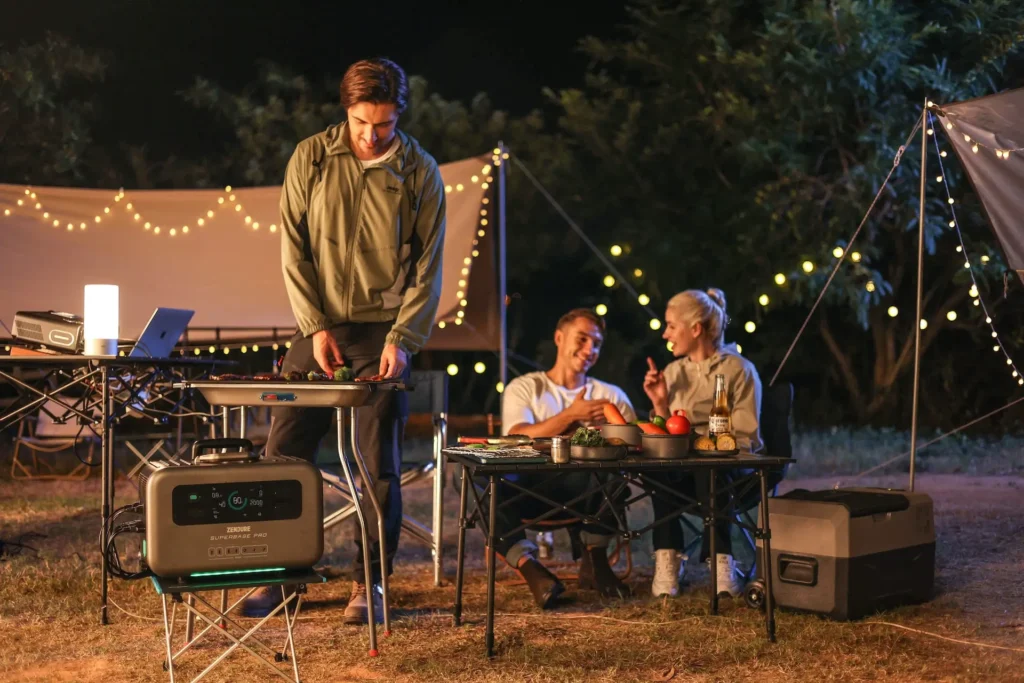Heading out on a camping trip with your trusty generator? Hold up just a minute before pressing that start button – have you given thought to How to Ground a Generator When Camping?
I know, I know – thinking about electrical systems and grounding equipment may not be as exciting as packing fishing rods or hiking boots. But taking the time to ground your generator correctly is a crucial safety step that protects both you and your devices.
Grounding your generator is a crucial safety step that protects both you and your devices. In this post, we’ll cover everything you need to know including:
- When generator grounding is required
- How generator grounding actually works
- Step-by-step grounding instructions
Let’s start by going over the basics of why generator grounding matters in the first place.

Why Proper Generator Grounding is Essential for Camping Safety
Grounding a generator simply means connecting it to the earth via a grounding rod and wire. This provides a safe path for excess electrical current to flow into the ground rather than through equipment or people.
Without proper grounding, a generator can pose serious risks like:
- Electric shock – Touching parts of an ungrounded generator could shock or electrocute you.
- Damage to appliances – Improper grounding can damage connected devices like phones and laptops.
- Overloading – Excess electricity can overload and fry a generator’s internal wiring.
- Fire hazards – Stray current could ignite nearby flammable materials.
Generator grounding routes dangerous electrical faults away from the equipment and people around it. While optional in some cases, it’s always better to be safe than sorry when dealing with electricity.
When You Need to Ground a Generator While Camping
Most manufacturers recommend grounding portable generators as a safety precaution. But when is it absolutely necessary?
You must ground a generator if:
- It will be connected to a home or RV electrical system rather than just an extension cord.
- Local laws or codes require generator grounding.
- The generator has a bonded neutral rather than floating neutral. Check the manual.
Grounding is optional if:
- Only using extension cords plugged directly into the generator.
- The generator has a floating neutral and isn’t connected to other electrical systems.
When in doubt, take the time to properly ground your generator, especially if it will supply power to an RV, trailer, or campsite electrical hookup. It provides an extra layer of protection.
How Does Grounding a Generator Work?
Now that we’ve covered when generator grounding is needed, let’s look at how it actually works.
Generator grounding relies on two main components:
The grounding rod – This rod made of copper, galvanized steel, or other conductive material is inserted into the earth, typically at least 8 feet deep.
The grounding wire – An insulated copper wire connects the generator to the grounding rod.
This wire gives excess electrical current an easier path to the earth rather than flowing through equipment or people. Simply put, generator grounding keeps electricity safely contained.
That covers the basic mechanism – but it’s also helpful to understand what electrical grounding actually achieves:
- Dissipates stray current into the earth.
- Prevents dangerous voltage spikes.
- Protects from lightning strikes.
- Reduces risk of damage, fire, and electric shock.
With the fundamentals covered, let’s get into the nitty-gritty of actually grounding your generator step-by-step.
How to Ground a Generator in 6 Simple Steps
Ready to properly ground your camping generator? Follow these steps:
Step 1: Choose a Suitable Location
Pick a spot at least 15 feet from your campsite that has soft, moist soil. Avoid rocky areas.
Step 2: Drive the Grounding Rod into the Earth
Use a mallet to pound the 8ft copper rod at least 2-3 feet into the ground.
Step 3: Remove Insulation from the Grounding Wire
Using wire strippers, remove 6-12 inches of insulation from each end of the wire.
Step 4: Connect One End of the Wire to the Grounding Rod
Wrap the exposed copper tightly around the rod and secure it with pliers.
Step 5: Connect the Other End of the Wire to the Generator
Loosen the grounding nut on the generator and wrap the wire’s exposed end around it. Tighten the nut back up.
Step 6: Test that Grounding is Working
Check grounding connections are secure. A multimeter can confirm the grounding resistance.
Be sure to check that generator grounding meets your local electrical code requirements too. And with that, you can fire up your generator knowing hazardous current has a safe outlet into the earth!
Common Generator Grounding Mistakes
Grounding a generator the wrong way can completely defeat the purpose. Avoid these errors:
- Not driving the grounding rod deep enough into moist earth.
- Using rusty or damaged grounding equipment.
- Loose, insecure connections to the generator or grounding rod.
- Using an undersized grounding wire that can’t handle the electrical load.
- Lack of periodic testing and inspection of the grounding system.
Correct any issues immediately – don’t take chances with electrical safety.
Grounding Tips for RV, Marine, and Backup Generators
There are some grounding considerations for other generator types:
- For RV generators, use a heavy-duty 4-wire cord to connect to the generator
- When grounding marine generators, consult Coast Guard regulations
- With backup generators, ensure neutral and ground are bonded at only one point
Generator Grounding Essentials to Remember
- Always ground a generator connected to a building or RV electrical system.
- Use a copper or galvanized steel grounding rod driven 2-3 feet into the earth.
- Securely connect the generator to the rod with heavy-gauge copper ground wire.
- Check local codes for specific grounding requirements in your area.
- Periodically test the generator’s grounding resistance for faults.
Safe camping is all about preparation. And making sure your generator is properly grounded gives you one less thing to worry about when you’re trying to relax!
While the basics of grounding a generator are straightforward, don’t hesitate to consult a professional electrician if you have any uncertainties. Taking a few simple precautions will ensure your safety and prevent potential disasters.
Frequently Asked Questions
How do you properly ground a generator?
Follow the generator manufacturer’s instructions to connect a copper grounding rod and wire from the generator frame to the earth. These routes stray electrical current away from the generator safely.
What are the benefits of grounding a generator?
Grounding a generator protects from electric shocks, damage to equipment, power surges, and fire hazards by giving excess electrical current a safe path to dissipate into the earth.
When is grounding a generator necessary?
You must ground generators that supply power to RVs, buildings, and other connected electrical systems. Grounding is optional but recommended for portable generators using extension cords.
How do I ground a generator without a grounding rod?
For portable generators, the metal frame pressed against moist earth can serve as an alternative grounding path when a grounding rod isn’t available. Consult your generator manual for whether this is approved.
Conclusion
Safe camping requires proper generator grounding to prevent shocks and electrical damage. Follow the step-by-step guide provided in this article to correctly ground your generator. Never take risks when it comes to electrical safety.
Let us know if you have any other generator grounding questions! Proper grounding is essential for protecting your equipment and personal safety when camping.




